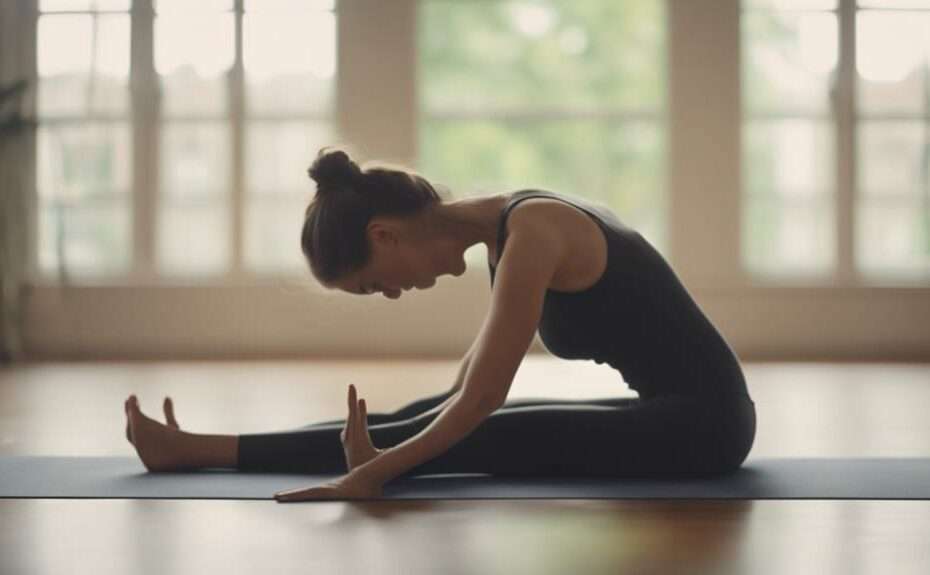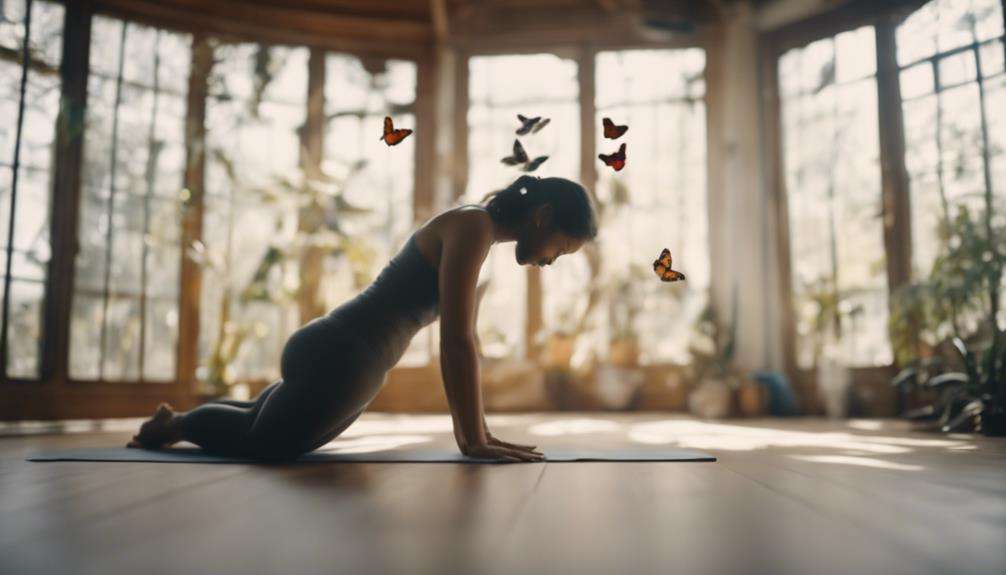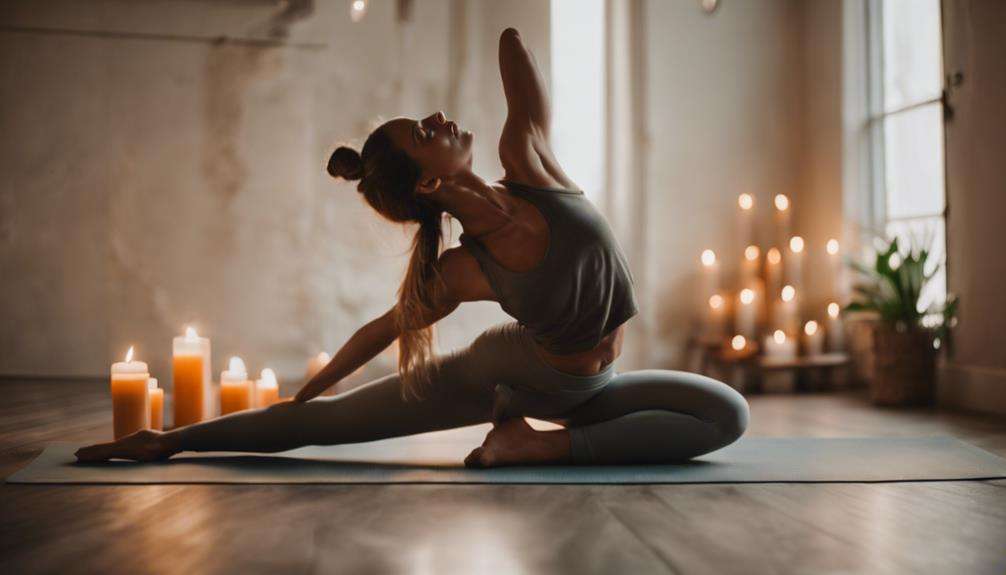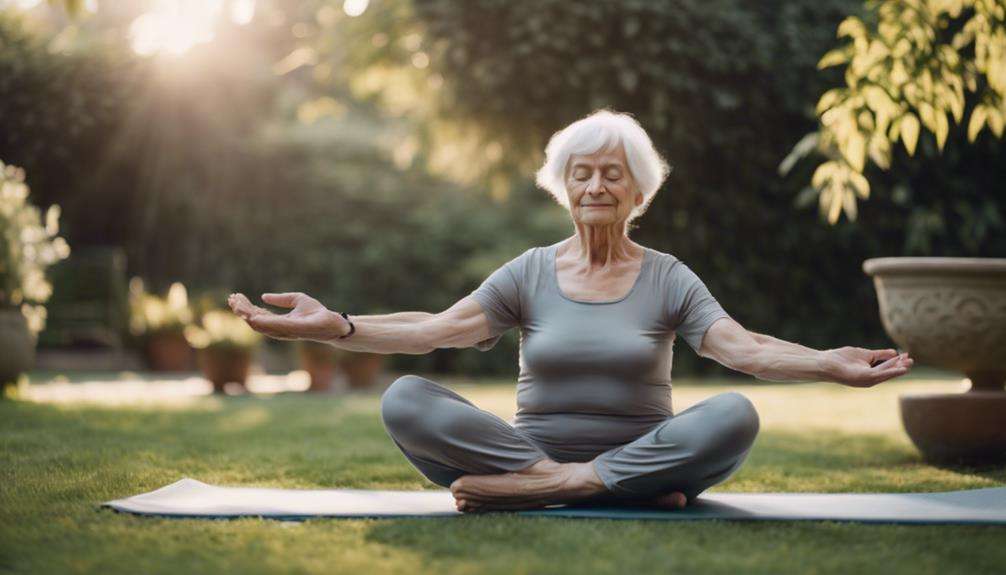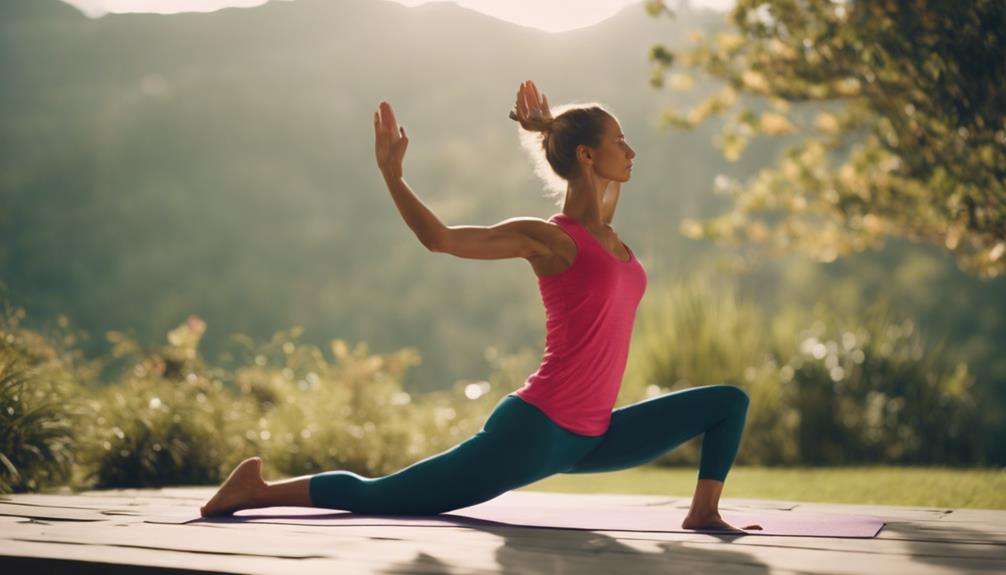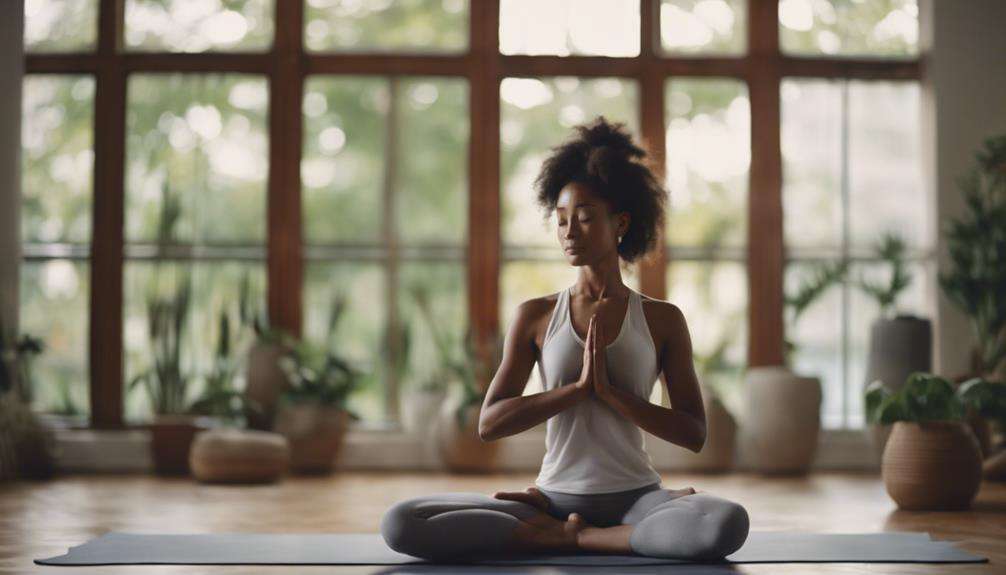When it comes to tackling back pain through yoga, think of your body as a garden that needs careful tending to flourish.
Imagine each stretch as a unique tool in your gardening shed, each serving a specific purpose to nurture and heal your aching back.
Curious to discover which stretches can offer you relief from that persistent discomfort? Let's explore a garden of poses that could be the key to unlocking a pain-free back and a more vibrant you.
Key Takeaways
- Child's Pose and Downward-Facing Dog alleviate lower back tension and promote flexibility.
- Seated Forward Bend strengthens the spine and provides relief for lower back pain.
- Engage muscles with poses like Downward-Facing Dog and Bridge Pose for strength and flexibility.
- Use poses like Pigeon and Thread the Needle to target specific areas like hips, lower back, and shoulders for relief.
Child's Pose
Practicing Child's Pose in yoga sessions can effectively alleviate lower back tension and discomfort. This restorative yoga pose, also known as Balasana, involves sitting back on your heels with arms extended forward, allowing for a gentle stretch along your spine and hips. By elongating the spine and gently stretching the back muscles, Child's Pose can help relieve stiffness and promote relaxation.
This posture is particularly beneficial for individuals experiencing back pain or looking to release tension in the lower back region. Regularly incorporating Balasana into your yoga practice can lead to improved flexibility, reduced back pain, and an overall sense of calmness and well-being.
The gentle nature of Child's Pose makes it a suitable option for all levels of yoga practitioners, offering a moment of rest and rejuvenation while targeting the areas of the body prone to tightness and discomfort.
Downward-Facing Dog
When practicing Downward-Facing Dog for back pain relief, you'll experience benefits like stretching and strengthening multiple muscle groups simultaneously.
To ensure proper alignment, remember to press into the hands and lift your sitting bones up, engaging the core.
Beginners can modify this pose by bending the knees slightly to ease into the stretch and gradually build strength and flexibility.
Benefits of Downward Dog
Stretching into the popular yoga pose known as Downward-Facing Dog can provide numerous benefits for alleviating back pain and improving overall muscle strength and flexibility. This pose helps stretch the hamstrings, relieving tension in the back while also engaging muscles like the latissimus dorsi and gluteus maximus to support the spine.
By focusing on proper alignment, such as lengthening the spine and slightly bending the knees, Downward Dog aids in releasing tension and promoting better posture. Holding this pose for up to a minute can effectively decompress the spine, offering relief for back pain, sciatica, and neck pain.
Regular practice of Downward-Facing Dog can enhance flexibility, strength, and posture, contributing to better back health over time.
Proper Alignment Tips
To achieve proper alignment in Downward-Facing Dog, position your hands shoulder-width apart and your feet hip-width apart. Engage your core muscles and press into your hands to lengthen the spine, relieving compression in the lower back.
Maintain a slight bend in your knees to prevent hyperextension and ensure even weight distribution throughout your body. Focus on elongating the spine by reaching your sitting bones up towards the ceiling while keeping your heels slightly lifted off the ground.
This pose provides a deep stretch for the hamstrings, shoulders, and back muscles, promoting relaxation and spinal decompression. Remember to prioritize proper form and alignment to maximize the benefits of the pose and alleviate back pain.
Modifications for Beginners
For beginners looking to modify Downward-Facing Dog, consider keeping your knees slightly bent to alleviate strain on the hamstrings and lower back. This adjustment can make the pose more accessible while gradually building strength and flexibility.
Placing a yoga block under your hands can help reduce pressure on the wrists, allowing you to focus on proper alignment and form. Remember to lengthen your spine and engage core muscles to support your back in this pose.
Keep your neck relaxed and gaze towards your feet to prevent unnecessary strain. As you progress, work on straightening your legs and bringing your heels closer to the mat to deepen the stretch and challenge yourself further in Downward-Facing Dog.
Cat-Cow Pose
When you practice Cat-Cow Pose, you engage various muscles like the erector spinae, rectus abdominis, and gluteus maximus, promoting spinal flexibility and mobility.
By moving through the inhale and exhale motions while balancing weight evenly, you release tension in your back effectively.
This pose, when done for at least 1 minute with focus on breath and body awareness, can significantly improve spinal health and alleviate discomfort.
Benefits of Cat-Cow
The Cat-Cow pose, known for its ability to stretch and mobilize the spine effectively, offers numerous benefits for individuals seeking relief from back pain. This pose targets various muscles such as the erector spinae, rectus abdominis, triceps, serratus anterior, and gluteus maximus.
By inhaling and arching the back while looking up (cow), and exhaling while rounding the spine and tucking the chin to the chest (cat), you can help improve flexibility and reduce tension in the back.
Regular practice of Cat-Cow for at least 1 minute can contribute to a healthier and more resilient spine. Incorporating this pose into your routine can be a valuable addition to alleviate back pain and promote spine health.
How to Do
To perform the Cat-Cow Pose effectively, position yourself on all fours, ensuring your weight is evenly balanced, and focus on inhaling as you look up and exhaling while tucking your chin towards your chest. Here are some key tips to help you master the Cat-Cow Pose:
- Engage your core muscles throughout the movement.
- Move slowly and mindfully, syncing your breath with each motion.
- Pay attention to the alignment of your spine to maximize the stretch.
- Feel the gentle mobilization of your spine as you transition between the two poses.
- Maintain a sense of awareness of how your body responds to the stretch to prevent overextension or strain.
Practicing these tips won't only help alleviate back pain but also enhance your overall yoga practice.
Cobra Pose
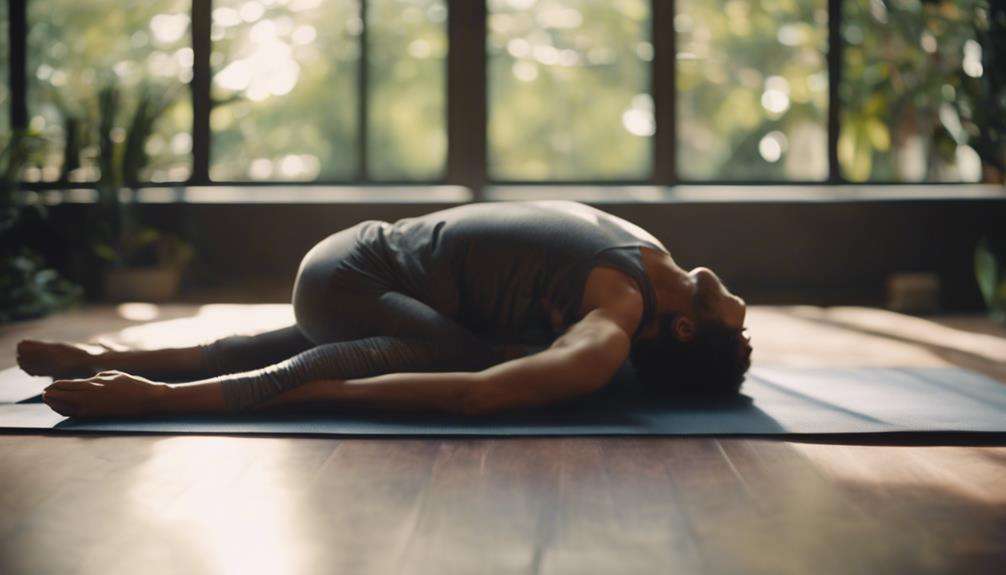
Stretch and strengthen your muscles effectively with the invigorating Cobra Pose in yoga. This backbend yoga posture targets the abdomen, chest, and shoulders, providing a deep stretch that helps in strengthening various muscles like the hamstrings, gluteus maximus, deltoids, triceps, and serratus anterior.
By engaging in Cobra Pose, you can alleviate back pain by mobilizing the spine and enhancing flexibility. This posture not only aids in reducing tension and discomfort but also promotes proper posture by strengthening the back muscles.
Regular practice of Cobra Pose contributes to overall back pain relief and improves spinal health. Remember to perform this pose mindfully, focusing on the extension of the spine and opening of the chest to reap its full benefits.
Include Cobra Pose in your yoga routine to experience the positive effects it can have on your back and overall well-being.
Seated Forward Bend
Strengthening and lengthening your spine, the Seated Forward Bend pose in yoga targets key muscle groups to alleviate lower back tension effectively. This stretch isn't only beneficial for your back but also promotes overall flexibility and relaxation.
Here are some key points about the Seated Forward Bend:
- Stretch: It provides a deep stretch to the hamstrings, calves, and hips, which can help reduce lower back pain.
- Tension Relief: By releasing tightness in the back muscles, this pose can alleviate discomfort caused by prolonged sitting.
- Posture Alignment: Regular practice of the Seated Forward Bend can improve your posture and spinal alignment, reducing the risk of future back issues.
- Mind Calming: In addition to physical benefits, this pose also helps calm the mind and reduce stress, contributing to overall well-being.
- Spinal Health: By strengthening and lengthening the spine, the Seated Forward Bend supports spinal health and flexibility.
Incorporating this pose into your yoga routine can provide significant relief for lower back pain and improve your overall physical and mental well-being.
Pigeon Pose
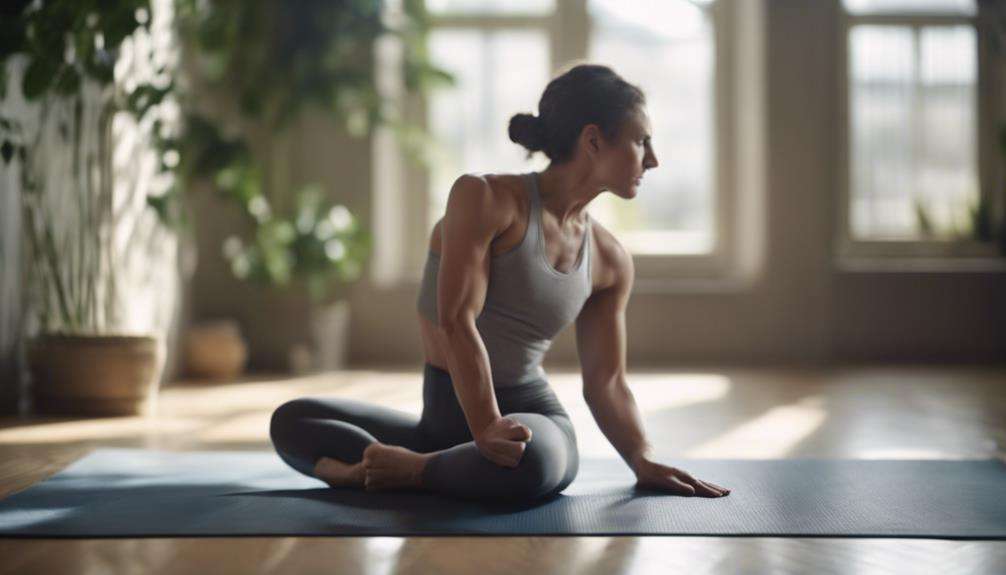
Engage your hip flexors and glutes effectively with the hip-opening yoga pose known as Pigeon Pose. This pose is particularly beneficial for relieving lower back pain by stretching and strengthening key muscle groups.
By practicing Pigeon Pose, you can improve the flexibility of your hips and lower back, which in turn helps reduce tension and discomfort in these areas. The pose targets the piriformis muscle, a small muscle located deep in the buttocks, whose tightness can contribute to lower back pain.
Regularly incorporating Pigeon Pose into your yoga routine can enhance overall mobility and release tightness in the lower back and hips, promoting a greater sense of ease and comfort. Through the gentle yet effective opening of the hips and release of tension in the lower back, Pigeon Pose offers a valuable stretch for individuals seeking relief from back pain within their yoga practice.
Bridge Pose
To enhance your back health and overall well-being, consider incorporating the beneficial Bridge Pose into your yoga practice.
Benefits of Bridge Pose:
- Stretches: Bridge Pose stretches the spine, providing relief from backaches and headaches.
- Strengthens: It works on strengthening the back, glutes, hamstrings, and core muscles.
- Mood Booster: This pose can help alleviate mild depression by improving circulation to the spine.
- Lower Back Pain Relief: Holding Bridge Pose for up to 1 minute can help alleviate lower back pain.
- Muscle Massage: Releasing slowly from Bridge Pose provides a gentle massage to the spine and back muscles.
Bridge Pose is a versatile yoga posture that not only stretches and strengthens various muscle groups but also offers mental benefits by reducing stress and anxiety. By incorporating this pose into your routine, you can work towards a healthier spine, stronger muscles, and improved overall well-being.
Thread the Needle Pose
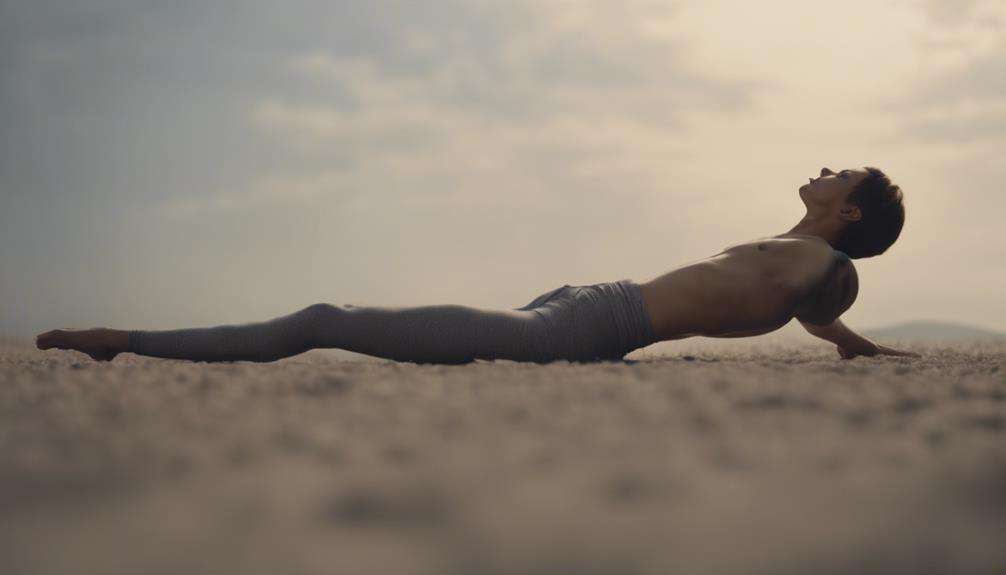
Promoting relaxation and enhancing spinal mobility, Thread the Needle Pose is a gentle yoga stretch that effectively targets tension in the upper back and shoulders. By threading one arm under the opposite arm and gently twisting, this pose stretches the muscles around the thoracic spine, providing much-needed relief for stiffness and discomfort.
The stretch opens up the chest and shoulders, improving flexibility and range of motion in the upper back. Thread the Needle Pose not only helps alleviate back pain but also promotes muscle relaxation, making it a beneficial addition to any yoga routine.
Whether you're a beginner or an experienced practitioner, this pose can be modified to suit your flexibility level, ensuring that everyone can benefit from its tension-relieving and shoulder-stretching properties. Incorporating Thread the Needle Pose into your practice can contribute to overall spinal health and enhance your well-being by targeting specific areas of tension in the upper back and shoulders.
Frequently Asked Questions
How to Deal With Back Pain With Yoga?
To deal with back pain through yoga, focus on gentle poses, core strength, and spinal twists. Practice breathing exercises, improve alignment, and cultivate a mind-body connection. Incorporate pelvic tilts, shoulder stretches, hip openers, and slow movements for relief.
What Type of Yoga Is Best for Back Pain?
For back pain relief in yoga, focus on restorative poses, gentle movements, core stability, slow flow, Yin yoga, alignment, supported postures, breathing techniques, mind-body connection, and modifying poses to suit your needs and abilities.
How Do You Stretch Your Back for Yoga?
To stretch your back for yoga, start with gentle movements like Cat stretch and Child's pose. Progress to poses like Cobra, Downward dog, and Bridge for strength. Use Seated twist, Sphinx pose, and Standing forward bend for flexibility. Finish with Thread the needle and Supine twist for relaxation.
Should I Do Yoga if I Hurt My Back?
If you hurt your back, doing yoga can be beneficial with proper alignment, breathing techniques, and gentle movements. Focus on core strength, mind-body connection, and slow progression. Use supported poses, modifications, and seek professional guidance for a restorative practice.
Conclusion
In conclusion, these yoga stretches are like magic for your back pain! Just a few minutes of practicing:
- Child's Pose
- Downward-Facing Dog
- Cat-Cow Pose
- Cobra Pose
- Seated Forward Bend
- Pigeon Pose
- Bridge Pose
- Thread the Needle Pose
can work wonders in relieving your discomfort.
So, grab your mat and get ready to say goodbye to back pain with these amazing stretches!
